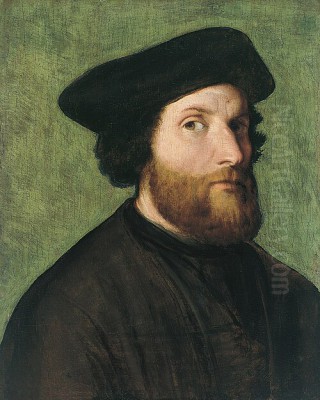
Lorenzo Lotto stands as one of the most intriguing and individualistic painters of the Italian High Renaissance. Born in Venice around 1480, his career unfolded largely outside the dominant artistic center of his birthplace, taking him through various cities in northern and central Italy. This itinerant life, coupled with a deeply sensitive and restless temperament, resulted in a body of work characterized by psychological depth, vibrant color, complex compositions, and a unique blend of Venetian traditions with influences from Northern Europe and Lombardy. Though overshadowed during his lifetime and for centuries after by contemporaries like Titian, Lotto was rediscovered in the late 19th century and is now celebrated for his penetrating portraits and emotionally charged religious paintings.
Early Life and Venetian Foundations
Lorenzo Lotto's origins lie in Venice, the heart of a flourishing artistic school renowned for its mastery of color and light. While concrete documentation of his training is scarce, art historians generally believe he may have spent time in the workshop of Alvise Vivarini, a painter whose style retained some of the sharpness and linearity of an earlier generation, possibly influencing Lotto's own precise draftsmanship. However, the overwhelming influence in Venice at the turn of the 16th century was Giovanni Bellini, whose atmospheric landscapes and gentle devotional figures set a standard for Venetian painting.
Lotto undoubtedly absorbed the lessons of Bellini and his circle, including the revolutionary innovations of Giorgione, whose enigmatic paintings explored mood and landscape in new ways. Lotto's early works, such as the Madonna and Child with St. Peter Martyr (1503, Capodimonte Museum, Naples), show an understanding of Bellini's compositional harmony and Giorgione's soft modeling (sfumato), yet already hint at a distinct personality through a certain nervous energy in the figures and a clarity of detail. His first major documented period of activity was in Treviso (1503-1506), where he painted the insightful Portrait of Bishop Bernardo de' Rossi (1505, Capodimonte Museum, Naples) and its accompanying allegorical cover, demonstrating early his skill in capturing likeness and conveying complex ideas.
The Itinerant Master: Travels and Commissions
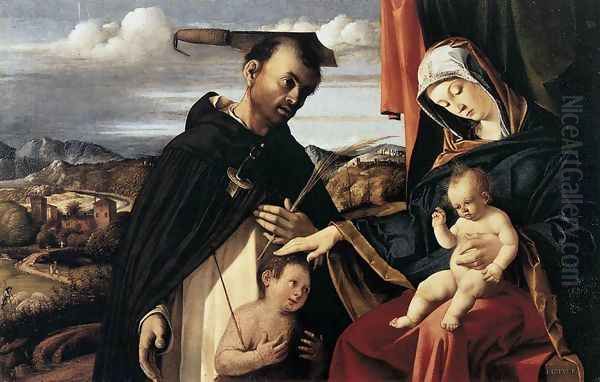
Unlike many Venetian artists who built their careers within the Republic, Lotto embarked on a life of frequent relocation. After Treviso, he moved to the Marches region, working primarily in Recanati between 1506 and 1508. Here, he completed significant works like the large Recanati Polyptych for the church of San Domenico (1508, Villa Colloredo Mels, Recanati), showcasing his ability to handle complex multi-panel formats while infusing traditional subjects with fresh observation and vibrant color.
A pivotal, though perhaps professionally frustrating, period followed in Rome (circa 1509-1512). Lotto arrived during the papacy of Julius II, a time when the city buzzed with artistic activity under the direction of giants like Raphael, then decorating the Vatican Stanze, and Michelangelo, working on the Sistine Chapel ceiling. While direct evidence of Lotto's commissions in Rome is limited, the experience undoubtedly exposed him to the monumental classicism and dynamic energy of the High Renaissance masters. This Roman sojourn likely broadened his artistic vocabulary, even if his personal style remained distinct from the prevailing Roman grandeur.
The most fruitful and stable period of Lotto's career occurred in Bergamo, a Venetian-controlled city in Lombardy, where he resided from 1513 to 1525. Patronized by the local aristocracy and religious confraternities, he produced some of his greatest masterpieces. These include large-scale altarpieces like the Martinengo Altarpiece (1513-16, San Bartolomeo, Bergamo), the Santo Spirito Altarpiece (1521, Santo Spirito, Bergamo), and the San Bernardino Altarpiece (1521, San Bernardino in Pignolo, Bergamo). In these works, Lotto combined Venetian color with Lombard realism and a heightened emotional intensity, creating complex narratives filled with keenly observed details and psychologically present figures. His time in Bergamo also saw him design intricate intarsia (marquetry) panels for the choir stalls of Santa Maria Maggiore, collaborating with the woodworker Giovan Francesco Capoferri.
A Unique Artistic Vision: Style and Technique
Lorenzo Lotto's style defies easy categorization. Rooted in the Venetian tradition of colorito (emphasis on color and brushwork), his art incorporates diverse elements absorbed during his travels. He blended the rich palette and atmospheric effects associated with painters like Titian and Giorgione with the sharp focus on detail and expressive intensity often found in Northern European art, particularly the work of German masters like Albrecht Dürer, whose prints circulated widely in Italy. Lombard realism, perhaps absorbed from artists like Vincenzo Foppa or Bramantino during his Bergamo years, also informs his precise rendering of textures and objects.
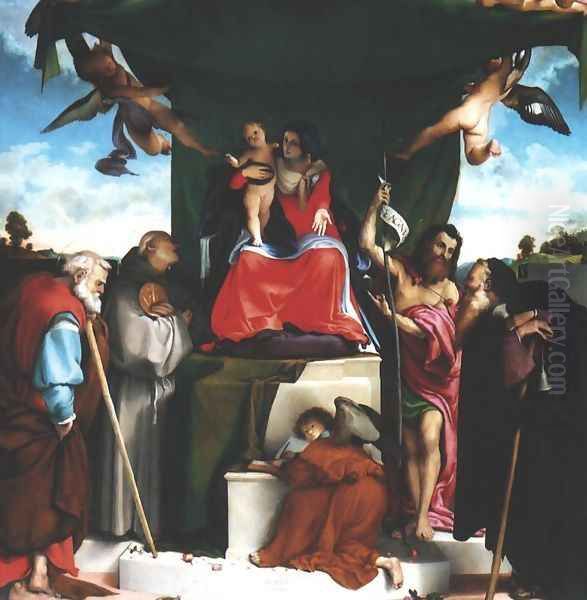
Lotto possessed a remarkable ability to convey psychological states. His figures, whether in religious scenes or portraits, often seem caught in moments of introspection, anxiety, or intense spiritual feeling. This is achieved through subtle nuances of expression, gesture, and posture. His use of light could be soft and unifying, in the Venetian manner, but also sharp and dramatic, employing strong chiaroscuro to model forms and create emotional tension. His color palette was often bold and unconventional, featuring vibrant, sometimes acidic, juxtapositions of hues like pinks, greens, and oranges, contributing to the distinctive emotional temperature of his work.
Compositionally, Lotto frequently deviated from the balanced harmony typical of the High Renaissance. He favored dynamic, asymmetrical arrangements, diagonal thrusts, and figures placed in unconventional spatial relationships, adding a sense of immediacy and sometimes unease. His meticulous attention to detail extended to fabrics, furnishings (like the Turkish carpets that appear frequently, reflecting Venetian trade links), and landscape backgrounds, all rendered with crisp precision. In his later works, tendencies associated with Mannerism become more apparent, including elongated figures, agitated movement, and heightened emotionalism.
Master of Portraiture
Lotto is now widely regarded as one of the most profound portraitists of the Renaissance. He moved beyond merely recording likeness to explore the inner lives of his sitters. His portraits are notable for their psychological penetration and often convey a sense of melancholy, restlessness, or quiet contemplation that feels remarkably modern. Unlike the often idealized or status-affirming portraits by his contemporary Titian, Lotto's subjects frequently appear more vulnerable and individually complex.
His early Portrait of Bishop Bernardo de' Rossi already shows his capacity for capturing a shrewd and perhaps wary personality. Later masterpieces, such as the Portrait of Andrea Odoni (1527, Royal Collection, Hampton Court), depict the Venetian collector surrounded by classical sculptures, capturing both his intellectual pursuits and a certain world-weariness. The Portrait of a Young Man in his Study (c. 1527, Gallerie dell'Accademia, Venice) is a quintessential example of Lotto's introspective portraiture, the sitter lost in thought amidst symbolic objects.
Lotto often incorporated symbolic elements into his portraits to allude to the sitter's character, profession, or state of mind. These might include books, tools, hourglasses, skulls (memento mori), flowers with specific meanings, or even small animals. The famous Husband and Wife (c. 1523-24, Hermitage Museum, St. Petersburg) is a complex double portrait laden with symbolism related to marriage and fidelity; it has also been central to debates, notably involving artist David Hockney, about the possible use of optical devices like concave mirrors by Renaissance painters to achieve precise realism, particularly in rendering complex patterns like the Turkish carpet depicted. Whether or not he used such aids, Lotto's portraits remain compelling for their human insight.
Religious Works: Faith and Feeling
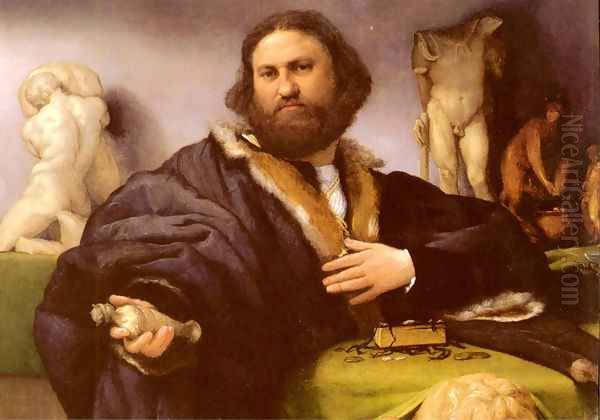
Religious subjects formed the core of Lotto's output throughout his career. His deep personal piety, evident later in life when he became a lay brother, permeates his sacred art. He excelled at creating an emotional connection between the viewer and the holy figures, often depicting them with a relatable humanity alongside their divine status. His altarpieces and devotional paintings are characterized by narrative clarity, inventive compositions, and intense feeling.
The early Asolo Altarpiece (Assumption of the Virgin with Saints Anthony Abbot and Louis of Toulouse, 1506, Duomo, Asolo) displays a youthful sweetness and luminous color. The Recanati Annunciation (c. 1528, Villa Colloredo Mels, Recanati) is one of his most original religious works, portraying the Virgin startled by the angel's arrival, with God the Father dramatically foreshortened above and a fleeing cat adding a touch of everyday realism and perhaps symbolic meaning. The Crucifixion from Monte San Giusto (1529-31) is a work of harrowing emotional intensity, focusing on the grief of the Virgin, St. John, and Mary Magdalene beneath a dramatically lit cross.
His large Bergamo altarpieces, like the Martinengo Altarpiece, are complex theological statements filled with numerous figures, rich details, and dynamic interactions, inviting prolonged contemplation. The St. Lucy Altarpiece (1532, Pinacoteca Civica, Jesi) vividly narrates scenes from the saint's life with dramatic lighting and expressive figures. Later works, such as the Madonna of the Rosary (1539, Pinacoteca Civica, Cingoli), demonstrate his continued ability to handle intricate compositions and convey popular devotional themes with sincerity and artistic brilliance. Lotto consistently sought to make the sacred accessible and emotionally resonant for the faithful.
Symbolism and Allegory
A distinctive feature of Lotto's art is his frequent use of complex symbolism and allegory. This reflects the intellectual climate of the Renaissance, with its interest in Neoplatonism, emblems, and hidden meanings. Sometimes the symbolism is relatively straightforward, as in the memento mori elements in portraits reminding viewers of mortality. At other times, it can be quite personal and enigmatic, requiring careful interpretation.
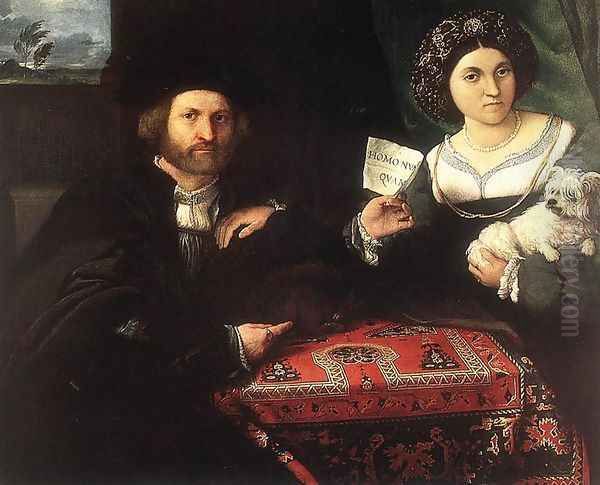
A famous example is Lotto's occasional use of a rebus based on his own name – depicting a small "lotto" game board – as part of his signature or within the composition itself. The allegorical cover he painted for the portrait of Bishop de' Rossi, depicting Allegory of Virtue and Vice (or Allegory of Chastity), is a clear instance of using symbolic figures to convey abstract concepts. Objects within his portraits and religious scenes often carry layered meanings: flowers might allude to the Virgin's purity or the transience of life, specific gestures could reference classical rhetoric or theological points, and animals might symbolize virtues, vices, or biblical passages. This intellectual dimension adds richness and complexity to his work, inviting viewers to engage not just emotionally but also intellectually.
Interactions and Influences
Lotto's peripatetic career brought him into contact with various artistic currents and likely numerous artists, though detailed records of his personal interactions are limited. His formative years in Venice exposed him to the foundational work of Alvise Vivarini and Giovanni Bellini, and the innovations of Giorgione. The influence of Northern art, especially Albrecht Dürer's prints, is undeniable in his attention to detail and expressive intensity. His time in Rome brought awareness of Raphael and Michelangelo, and perhaps the architectural ideas of Bramante, which may be reflected in the settings of some paintings.
In Lombardy, he would have encountered the regional tradition of realism, possibly engaging with the work of artists like Vincenzo Foppa, Bramantino, and his Brescian contemporaries Girolamo Romanino and Moretto da Brescia, whose styles also blended Venetian color with Lombard solidity. While in Venice, he inevitably operated in the shadow of the dominant Titian, whose grander, more sensuous style differed significantly from Lotto's more intimate and psychologically charged approach. He would also have known other Venetian painters like Palma Vecchio and possibly competed for commissions with artists like Pordenone. Later in Venice, he would have been aware of the rising generation including Tintoretto and Veronese, though their dynamic, large-scale Mannerist works represent a different sensibility. He also interacted with figures in other fields, like the architect and sculptor Jacopo Sansovino, a key figure in transforming Venice's urban landscape. Lotto's unique style emerged from this rich tapestry of influences, synthesized through his highly individual artistic personality.
Later Years and Legacy
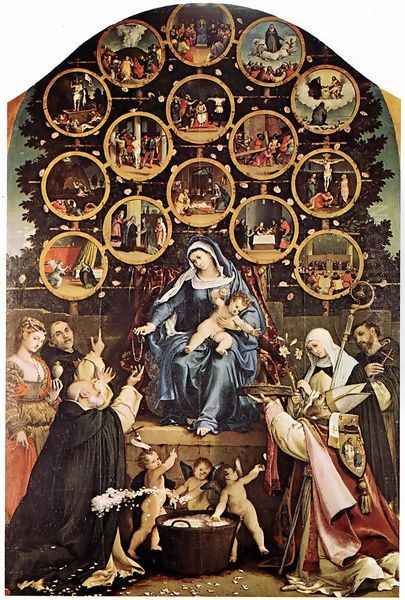
Lotto returned to Venice around 1525 but seemed to find it less congenial than Bergamo. He faced stiff competition, particularly from Titian and his circle, which included the influential writer Pietro Aretino, who sometimes criticized Lotto's work. He continued to receive commissions, often from patrons in the Marches, requiring further travel to cities like Ancona, Macerata, and Jesi during the 1530s and 1540s. His surviving account book, the Libro di spese diverse, kept meticulously from 1538 onwards, provides invaluable insights into his commissions, expenses, personal life, and financial struggles during these later years. It paints a picture of a devout, somewhat solitary man, often anxious about finances and the reception of his work.
Feeling increasingly isolated and perhaps seeking spiritual solace, Lotto moved in 1552 to Loreto, a major pilgrimage site in the Marches housing the Basilica della Santa Casa. In 1554, he became an oblate, or lay brother, associated with the Holy House, effectively donating himself and his remaining possessions to the shrine. He continued to paint modestly in his final years and died in Loreto sometime between September 1556 and July 1557. His legacy was quickly obscured. Giorgio Vasari, in his influential Lives of the Artists (1568 edition), gave him only a brief and somewhat dismissive mention, contributing to his subsequent neglect by art history for centuries.
Rediscovery and Modern Appreciation
Lorenzo Lotto remained a relatively obscure figure until the late 19th century. The crucial turning point came with the publication of Bernard Berenson's monograph in 1895. Berenson, a highly influential connoisseur and art historian, championed Lotto as a master of psychological portraiture, praising his ability to capture subtle states of mind and emotion. Berenson saw Lotto as a precursor to modern sensibilities, an artist uniquely attuned to the inner lives of his subjects, contrasting him favorably with the more outwardly focused grandeur of many of his contemporaries. This reassessment fundamentally shifted Lotto's position in the canon of Renaissance art.
Throughout the 20th and into the 21st century, scholarly interest in Lotto has continued to grow. Art historians have delved deeper into his complex iconography, his innovative techniques, his relationship with patrons, and the cultural contexts of the various cities where he worked. Scientific analysis has shed light on his materials and methods. Major international exhibitions, such as the comprehensive show held in Washington D.C., Bergamo, and Paris in 1997-98, and the exhibition focusing specifically on his portraits at the Prado Museum in Madrid and the National Gallery in London in 2018-19, have brought his work to a wider public and solidified his reputation.
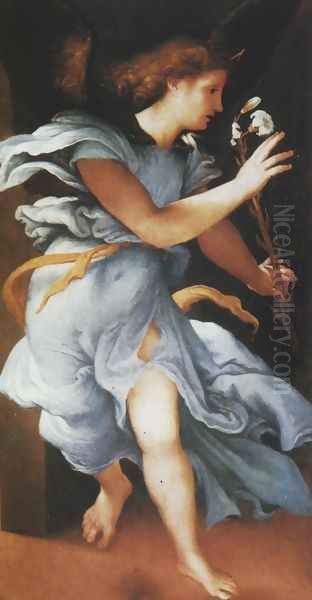
Today, Lorenzo Lotto is recognized not merely as a provincial or eclectic painter, but as a major, highly original master of the Italian Renaissance. His ability to combine technical brilliance with profound emotional and psychological insight, his restless creativity, and the sheer beauty and intensity of his paintings ensure his enduring fascination and importance in the history of art. He stands as a testament to the rich diversity of artistic expression during the Renaissance, an artist whose deeply personal vision continues to resonate with viewers centuries later.